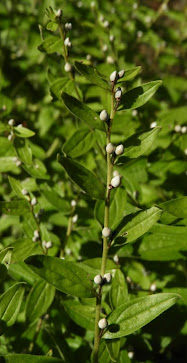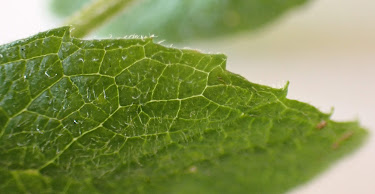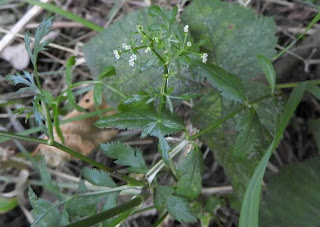These three natives grow on woodland rides in Vicar's Allotment at Trellech near Monmouth: the first two within a metre of each other. The Allotment is on Victorian maps but all these plants are on or near modern forestry tracks.
- Silverweed, Potentilla anserina
- Square-stalked St John's-wort, Hypericum tetrapterum
- Round-leaved Mint, Mentha suaveolens
Silverweed, Potentilla anserina
This plant from the Rosaceae family is so common as it is happy to grow in many types of soil and so recognisable I did wonder about including it in the blog but then I discovered its rich history. Botanical details first! The first two photos were taken in late August on a wet track side. The flower is five petalled and the petals are about twice the length of the sepals. This one is looking a little worn and was the last in bloom.
The uppersides of leaves vary from silvery, especially earlier in the season as here, to dull green. Most silver leaves had faded by mid September.
They are pinnately cut into 3-12 pairs of oval, toothed leaflets interspersed with additional tiny leaflets which can be seen below.
All of the subsequent photos were taken in mid September in order to focus more on the leaves. The underside seems to show the form better.
The underside of the leaves is usually silvery white. In this colony all of them were.
The underside is covered with very fine white hairs. The saw toothed leaflets are clear here as well as the additional tiny leaflets.
The history of this common plant is amazing. It was reputed to be picked by Roman soldiers and used as a padding in their boots. This perhaps gave rise to the local name Traveller's Ease in Warwickshire.
Potentilla means powerful despite its size and anserina means pertaining to geese which enjoy it: hence the local name Goose-grass in Somerset, Gloucestershire, Yorkshire and many other counties.
Until the end of the nineteenth century the roots were eaten in times of famine especially in the Scottish highlands and islands. It was said in North Uist a man could keep himself fed on a square patch of land of his own length by growing Silverweed. It was cultivated and very important in the diet of people in Scotland before potatoes became common in mid eighteenth century.
Roots were baked, boiled, roasted, dried and ground into a rough flour for bread or porridge. They taste a bit like parsnips.
It has astringent, anti-catarrhal, anti-inflammatory and diuretic properties. The dried leaves can be used to relieve sore throats, gum infections and mouth ulcers. They can also be used as a compress. Even more detail is available on the Plantlife website: link at the bottom.
Pass Silverweed with a respectful nod next time!
Square-stalked St John's-wort, Hypericum tetrapterum
This member of the Hypericaceae family is growing within a metre or so of the Silverweed. It too likes the damp edge of the woodland track. The main ID point is the square stalk with narrow but distinct wings on the angles. The stem is also reddish.
Leaves more or less clasp the stem.
The petals are pale yellow while the sepals are narrow and pointed.
In mid September the plant had moved on to fruit and the sepals can be seen very clearly. Perhaps some of the black glands along the leaf edges are clearer too.
Round-leaved Mint, Mentha suaveolens
From the Lamiaceae family, I believe this to be Round-leaved Mint and it was accepted as such on #Wildflowerhour on 30/8/20 but there are hybrids. Happy to hear from anyone who on examining a larger range of photos has an opinion!
Leaves are roundish: slightly less than a circle, suborbicular, or oblong-ovate. They are hairy as are the stems which branch frequently.
The leaves are stalkless or have very short stalks.
The following macro photographs were taken in mid September.
The leaves are strongly rugose and appear from above to have rounded teeth but they are bent downwards like cats' claws. No other Mint has this ID feature except for a few hybrids between this and other species of Mint.
The pale flower heads are spike-like and congested. The calyx appears to be bell-shaped and the flowers, in whorls, have 4 petals with filaments tipped by a red to purple anther.
The style is white and splits into two stigmas at the end.
It would be good to hear from anyone who has an opinion on the ID. Hopefully there is enough information to decide.
This concludes the look at three plants in Vicar's Allotment near Monmouth. The next blog should cover plants found in Gloucestershire.
Acknowledgements
Harrap's Wild Flowers
Stace 4
https://www.plantlife.org.uk/uk
https://www.first-nature.com/
https://www.naturespot.org.uk/
https://wildflowerfinder.org.uk/
http://www.seasonalwildflowers.com/
http://botanical.com/





















































